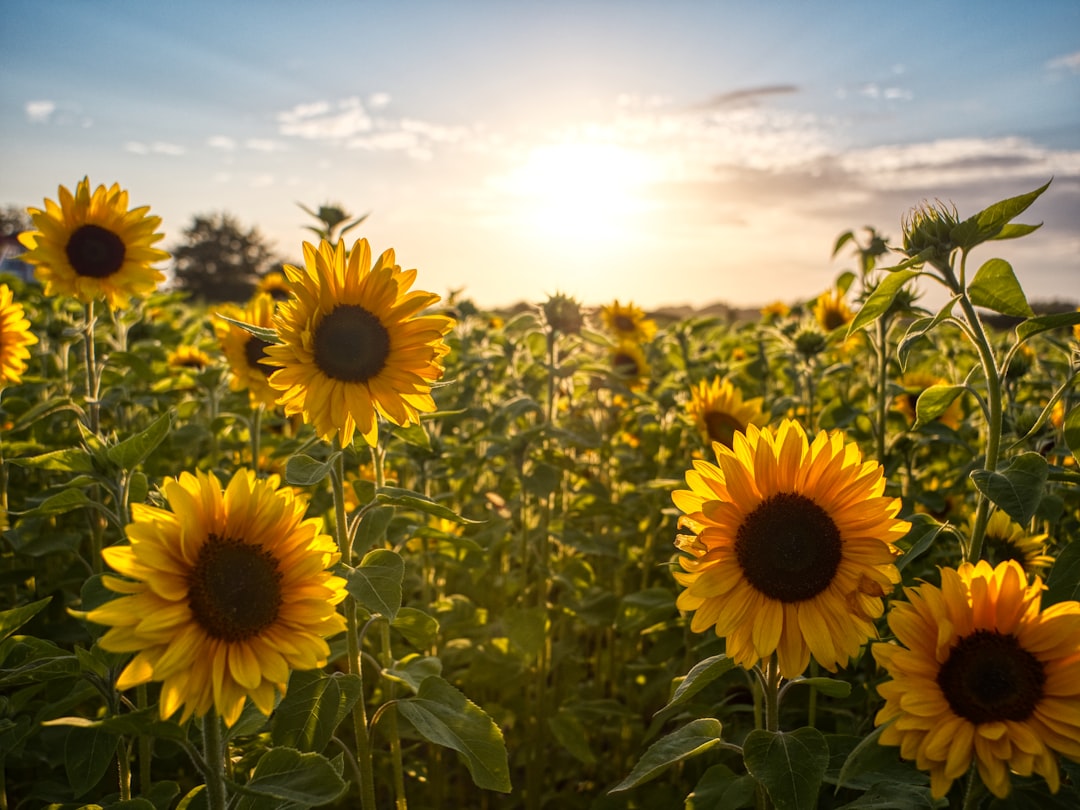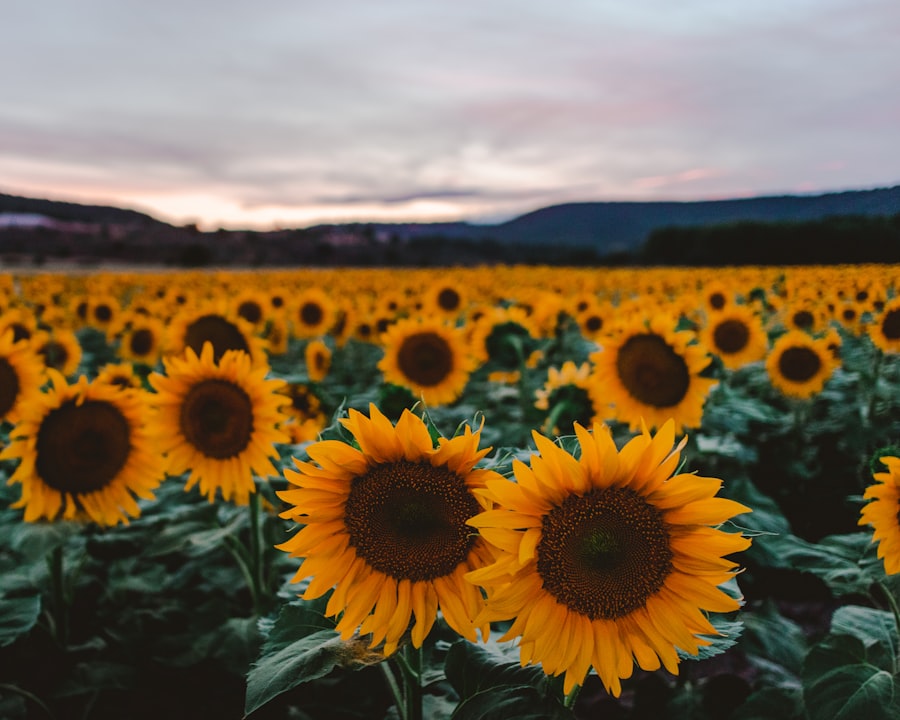Harvesting Sunflowers: A Step-by-Step Guide

Sunflower harvesting is an important process that requires careful planning and execution. Sunflowers are a popular crop due to their vibrant colors and versatility. They can be used for various purposes, such as oil production, birdseed, and even as a decorative element in floral arrangements. Proper harvesting techniques are crucial to ensure maximum yield and quality of the sunflowers.
Key Takeaways
- Sunflowers should be harvested when the back of the flower head turns yellow and the seeds are plump and firm.
- Before harvesting, it is important to prepare the field by removing weeds and debris and ensuring the soil is dry.
- Tools required for sunflower harvesting include a sickle, pruning shears, gloves, and a bucket or basket.
- Harvesting sunflowers by hand involves cutting the stem below the flower head and placing it in a bucket or basket.
- Harvesting sunflowers with a machine involves using a combine harvester with a specialized header attachment.
- To efficiently harvest sunflowers, it is important to work in dry weather conditions and to avoid overloading the harvesting equipment.
- After harvesting, sunflowers should be dried and stored in a cool, dry place to prevent mold and mildew growth.
- Sunflowers can be used for a variety of purposes, including oil production, birdseed, and decorative arrangements.
Choosing the Right Time for Harvesting Sunflowers
Determining the right time for harvesting sunflowers is essential to achieve optimal results. Several factors should be considered when deciding when to harvest. One important factor is the maturity of the sunflowers. Sunflowers are typically ready for harvesting when the back of the flower head turns yellow or brown and the petals start to dry out and fall off. Another factor to consider is the moisture content of the sunflowers. It is recommended to harvest sunflowers when the moisture content is around 10-12%. Harvesting too early can result in lower oil content, while harvesting too late can lead to shattering of the seeds.
Preparing for Sunflower Harvesting
Before starting the sunflower harvesting process, it is important to prepare the area and gather all necessary tools and equipment. Clearing the area around the sunflowers is crucial to ensure easy access and prevent any obstructions during harvesting. It is also important to check the weather conditions before harvesting. Harvesting on a dry day is ideal as wet conditions can lead to mold growth and decreased seed quality. Gathering all necessary tools and equipment, such as pruning shears or a sickle, buckets or bins for collecting the harvested sunflowers, and gloves for protection, will help make the harvesting process more efficient.
Tools Required for Sunflower Harvesting
| Tools Required for Sunflower Harvesting |
|---|
| Sunflower harvesting machine |
| Harvesting sickle |
| Pruning shears |
| Hand gloves |
| Buckets or crates |
| Transportation vehicle |
There are several tools that are commonly used for sunflower harvesting. These tools help make the process easier and more efficient. Pruning shears or a sickle are commonly used to cut the sunflower stalks. These tools have sharp blades that can easily cut through the thick stalks. Buckets or bins are used to collect the harvested sunflowers. Gloves are also important to protect hands from any thorns or prickly parts of the sunflower plant. Additionally, a ladder or step stool may be needed for harvesting sunflowers that are taller and harder to reach.
Harvesting Sunflowers by Hand
Harvesting sunflowers by hand is a common method used by many farmers and gardeners. It is a simple and straightforward process that can be done with minimal tools and equipment. To harvest sunflowers by hand, start by cutting the stalks with pruning shears or a sickle, leaving about 12-18 inches of stem attached to the flower head. Place the harvested sunflowers in buckets or bins, making sure not to overcrowd them. It is important to handle the sunflowers with care to avoid damaging the petals or seeds. Once all the sunflowers have been harvested, they can be transported to a designated area for further processing or storage.
Harvesting Sunflowers with a Machine

Machine harvesting is another method that can be used for harvesting sunflowers, especially on larger farms or commercial operations. Machine harvesting is more efficient and can save time and labor compared to hand harvesting. There are different types of machines that can be used for sunflower harvesting, such as combine harvesters or specialized sunflower harvesting machines. These machines are equipped with cutting mechanisms that can efficiently cut and collect the sunflower heads. However, machine harvesting may not be suitable for smaller-scale operations due to the cost and maintenance of the machines.
Tips for Efficient Sunflower Harvesting
To maximize efficiency during sunflower harvesting, there are several tips that can be followed. One tip is to start harvesting early in the morning when the weather is cooler and the moisture content of the sunflowers is lower. This can help prevent mold growth and ensure better seed quality. Another tip is to work in small sections or rows to avoid overcrowding and confusion. It is also important to handle the sunflowers with care to avoid damaging the petals or seeds. Additionally, it is recommended to have a designated area for collecting and storing the harvested sunflowers to prevent any damage or loss.
Post-Harvesting Sunflower Care
Proper post-harvest care is crucial to maintain the quality and longevity of the harvested sunflowers. After harvesting, it is important to remove any excess foliage or debris from the sunflower heads. This can be done by gently shaking or brushing off any loose petals or leaves. It is also recommended to remove any damaged or discolored seeds to prevent mold growth. Once the sunflowers have been cleaned, they should be stored in a cool and dry place to prevent moisture buildup and spoilage.
Storing Sunflowers Properly
Storing sunflowers properly is essential to maintain their quality and freshness. Sunflowers should be stored in a cool and dry place, away from direct sunlight and moisture. It is recommended to store them in a well-ventilated area to prevent mold growth. Sunflowers can be stored in buckets or bins, making sure not to overcrowd them. It is also important to check the stored sunflowers regularly for any signs of mold or spoilage and remove any damaged or discolored seeds.
Using Harvested Sunflowers for Different Purposes
After harvesting, sunflowers can be used for various purposes. One common use of harvested sunflowers is for oil production. Sunflower oil is a popular cooking oil due to its mild flavor and high smoke point. Harvested sunflowers can also be used as birdseed, providing a nutritious food source for birds during the winter months. Additionally, sunflowers can be used as a decorative element in floral arrangements or as a natural dye for fabrics. The versatility of sunflowers makes them a valuable crop that can be utilized in different ways.
Proper sunflower harvesting and care are essential for maximizing yield and quality. Choosing the right time for harvesting, preparing the area, and gathering the necessary tools and equipment are important steps to ensure a successful harvest. Whether harvesting by hand or with a machine, following proper techniques and handling the sunflowers with care is crucial. Post-harvest care, including cleaning and storing the sunflowers properly, is also important to maintain their quality. By utilizing harvested sunflowers for different purposes, their value can be maximized. Overall, proper sunflower harvesting and care are key to achieving optimal results and utilizing this versatile crop to its fullest potential.
If you’re looking for expert advice on how to harvest a sunflower, look no further than Lawn World. Their comprehensive guide on sunflower harvesting provides step-by-step instructions and valuable tips to ensure a successful harvest. From determining the right time to harvest to properly cutting and storing the sunflowers, this article covers it all. Check out Lawn World’s article on sunflower harvesting here for all the information you need to make the most of your sunflower garden. And while you’re at it, don’t forget to explore their website’s sitemap for more helpful resources on lawn care and gardening.
FAQs
What is the best time to harvest sunflowers?
The best time to harvest sunflowers is when the back of the flower head turns yellow and the petals start to dry out and fall off.
How do I know if a sunflower is ready to be harvested?
A sunflower is ready to be harvested when the back of the flower head turns yellow and the petals start to dry out and fall off. The seeds should also be plump and firm.
What tools do I need to harvest sunflowers?
To harvest sunflowers, you will need a pair of sharp scissors or pruning shears, a bucket or basket to collect the flower heads, and gloves to protect your hands from the prickly stems.
How do I harvest sunflowers?
To harvest sunflowers, use a pair of sharp scissors or pruning shears to cut the stem of the flower head about 4-6 inches below the head. Place the flower heads in a bucket or basket.
What should I do with the harvested sunflowers?
Harvested sunflowers can be used for a variety of purposes, such as making bird feeders, decorating your home, or roasting the seeds for a healthy snack. You can also save the seeds to plant more sunflowers next year.
How do I store harvested sunflowers?
To store harvested sunflowers, hang them upside down in a dry, well-ventilated area for a few weeks until they are completely dry. Once dry, remove the seeds and store them in an airtight container in a cool, dry place.



